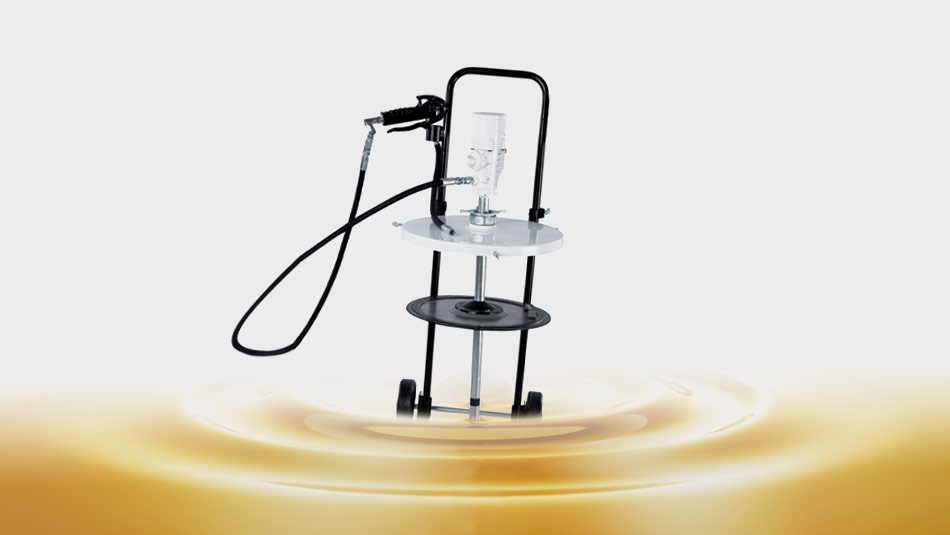Everything you need to know about pneumatic grease pumps

To lubricate all mechanical devices, the choice of a pneumatic grease pump is the best solution to guarantee the proper operation of your equipment and to protect it from wear and corrosion. Easy to use, discover the grease pump: a pneumatic tool that enables very precise injection of viscous and greasy fluids.
Need advice?
Our team of experts is here to help you.
You can contact us via a simple click:
Definition of a pneumatic grease pump
Pneumatic pumps run on compressed air.
To simply describe the operation of this type of displacement pump, they are often compared to a syringe. But to be more precise, let's look at the mechanism of these pneumatic tools in greater detail.
First, the piston moves backwards. A partial vacuum is created in the chamber. The check valve on the suction hose opens and sucks in the grease. Then, the piston moves forward, placing the chamber under pressure. The upper check valve now opens, enabling the evacuation of the fluid via the discharge hose.
To keep the pump primed, it is necessary for the air compressor to remain in constant operation.
Pumps equipped with a dual-action telescopic ram.
The wet parts and seals of the pumps are designed in suitable resistant materials:
- steel or stainless steel
- leakproof nitrile (NBR)
- PTFE plastic polymer, often called Teflon, which is particularly resistant to abrasive chemical products and possesses a very low friction coefficient
The pump body incorporates a pressure valve or flow regulator that creates a bypass in case of an obstruction or clogging in the discharge hose.
Our grease pumps are accompanied by a barrel cover and follower plate that prevents suction irregularities and the compression of grease at the bottom of the container so that it can be correctly pumped.
The gun nozzle is equipped with 4-jaw end fittings and a rotary articulation on a bearing with an interchangeable connection or hydraulic couplings.
What are grease pumps used for?
These tools ensure the light lubrification of the mechanical parts of agricultural machinery and vehicles as well as the parts of tractor diesel engines...
This type of pump is also used for the maintenance of various hand tools: chainsaws, power chisels, drills, sanders, angle grinders, etc. The purpose is to grease the bearings to reduce friction and to protect the mechanisms from premature wear and abrasion.
For this type of application, we propose manual pumps with grease cartridges. These mini pumps are lighter but must be regularly reloaded and are often less robust. The same function can also be performed with a pneumatic grease pump.
The advantages of pneumatic grease pumps
Very easy to use and disassemble, the rigid and cylindrical pipe of the pump is placed in the tank and the dummy bung is screwed onto the follower plate.
The cover must then be replaced. Ensure that the suction tube nozzle is properly installed at the bottom of the drum.
To finish, simply tighten the nut by hand. The pump is ready for use.
You can now start the air compressor.
Then simply aim the delivery gun and press the trigger to pump the required quantity of grease.
Very manageable and ergonomic, the articulated pneumatic gun enables precise and homogeneous grease delivery.
By closing the gun, the pump can remain in the stop position with no damage to the pump or air consumption.
Another advantage is that it is possible to create several greasing points to serve different work stations in a workshop. In this case, it is necessary to add connectors and an adaptor for each additional gun.
Pneumatic grease pumps offer high pressure, come in various pressure ratios and are not limited to pumping small quantities like those of standard cartridges. The flow rate is generally indicated in grammes per minute in the manual.
How to choose a grease pump
The choice depends on several factors:
- The type of lubricating liquids used: high-viscosity and/or sticky grease, bulk universal grease, etc.
- The content of grease tanks and the use define the length of the flexible hose and probes. There are different dimensions that enable installations on various ranges of containers, from the 12 kg can to 200 kg drums. Larger capacities above 200 kg require bespoke construction.
- Pressure
The grease orifice on pneumatic grease pumps is relatively small. It is therefore necessary to provide the pressure necessary to distribute the grease through grease points that are often very narrow. Moreover, it is important to look at the pressure ratio. For example, a pump with a 55:1 pressure ratio means that with an air pressure of 10 bars at the pump inlet, the outlet pressure is 550 bars.
It is important to know the isometry, length, diameter and the differences in the heights of the flexible hoses and discharge network to determine the pressure necessary for the greaser.
We strongly recommend you contact us to help you make the right choice. There is a wide range of models and the best product will not be the same for private DIY use or for industry.
All our pumps can be enhanced with various accessories: a portable trolley for easier handling, an oval-gear meter gun, a built-in reel with 10 metres of flexible hydraulic hose, an air regulator with pressure gauge, etc.
